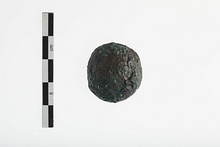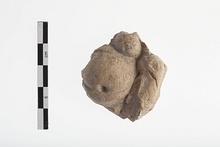| Collection: | Corinth | |
| Type: | Basket | |
| Name: | Nezi Field, context 1085 | |
| Area: | Nezi Field | |
| Title: | Dump Fill W of Wall 1007 | |
| Notebook: | 1107 | |
| Context: | 1085 | |
| Page: | 0 | |
| Date: | 2013/04/19 | |
| Stratum: | Stones (pebbles, cobbles), tile, ceramics, plaster, mortar, marble, carbon, glass, iron, bronze, lead | |
| Description: | The soil color is mixed. The soil compaction is soft. The soil is very poorly sorted. It is sandy silt. | |
| Notes: | 1085 begun upon completion of 1084. It seems to be a variegated dump fill at the outset. A piece of thick concrete & pebble pavement: Th. 0.07-08 m; L 0.22, W 0.17. And another, smaller piece of same. Two joining fragments, broken in antiquity, of an octagonal paver -- schisty limestone (? - JH) -- the same as the fragments found earlier in contexts [ ] above. Much cement/plaster in the matrix, and marble revetment. Panos starts a marble bucket, then another. The sediment varies in color: light brownish brown, dark yellowish brown, dark greyish grey. Many (ca. 50+) fragments of the mortar/pebble stuff, all concentrated at the SW corner of the context, not beyond the line of the E end of Wall 807. Most of large cobble/small boulder size. Could be from a fountain? At the NW corner of the context, the sediment reddish brown. Clearly earlier material all through: Black Gloss, Red Figure, Early Roman. Less marble here than to the SW. Second bucket of ceramics. Olive pits. Lamps of all sorts. More olive pits, in the ca. 1 m S of Wall 1033. Cobble-size pieces of iron slag. Start a third bucket of pottery as we move past the line of the E end of Wall 1033. Reddish brown moving E. A bit of lead, with hole from a square-shanked object. Fourth bucket of pottery started. Panos returns to a second pass from the SW: black sediment still and the pebble/mortar fragments. Here the deposit is laid against the small-stone foundations under Wall 807. Meanwhile as Tasos Tsogas proceeds NE, to the N of Cut 1009, still a small piece of the pebble/mortar matrix here and there, though in nothing like the same quantities. A greater percentage of rounded river cobbles here. Context left open at end of day, end of week, end of session: return on Monday - to be continued. [22 April 2013:] Monday morning resume excavation. Tasos Kakouros has returned from vacation, replacing Vassilis Kollias on shovel. A piece of folded-over iron sheet (?) found ca. 1 m E of the lone stone exposed by 1081, just W of the cut-edge running S from Wall 1033. There are several things exposed by the removal of 1085: At the easternmost extent, a narrow lip along the W face of Wall 1007. The depression that 1085 filled was bordered on the S by the robbing trench 1009: so the postulated wall and pavement robbed out by 1009 still existed when 1085 was laid down. The sediment underlying 1085 N of 1009 is reddish brown; west of the W extent of 1009 the sediment is reddish brown with pebbles and cobbles: is there a relationship between the wall robbed out by 1009 and the edge of the pebbles? Possibility: the wall of 1009 formerly extended further N (with the associated pavement?), the pebbles were laid against it, then the wall and pavement were robbed out, with the resultant void filled by the reddish-brown sediment now visible. Future excavation will hopefully clarify the nature of the pebble deposit. HOWEVER, the bottom of 1009 is higher than the exposed top of the pebble deposit, hence the posited northward extension of the wall would have to have been more deeply bedded: an unlikely proposition. The relationship between the robbed-out wall and the pebble deposit may be illusory, but future excavators should keep it in mind. The pebble deposit extends W to a scarp, roughly N-S and in line with the W end of Wall 1033. Here it can be seen to overlie a non-pebbly deposit, dark reddish brown. This, in turn, abuts or overlies a dark(er) reddish brown deposit with tiles and carbon (or they are the same deposit, perhaps a dump fill). If they are the same, they/it extends W to the area where an ashy destruction layer is visible, exposed by the removal of Deposit 1084. In this W reddish-brown deposit fragments of cement are visible. Probably all a big dump fill. S of the Lone Stone exposed by 1081, the removal of 1085 exposed the tops of two or three more irregular stones perhaps on axis with the Lone Stone. S of these, there are some tiles bedded in the matrix of Wall 947, whereas otherwise the wall seems to be constructed exclusively of stones. And so we beat on, boats against the current, borne back ceaselessly into the past. | |
| Context Pottery: | Fineware. ER84 bodysherds. ; Fineware. Preroman308 bodysherds. ; Cooking ware. cloche lid. 7 rims. ; Fineware. Red Figure, unidentified. 1 bodysherd. (saved to lot) .Human figure of a man; Fineware. Geometric, oinochoe. 1 handle. (saved to lot) .; Fineware. Classical, askos. (saved to lot) .Trick vase? Or more likely askos, as Agora XII, no. 1167; Fineware. Rom- AfRS, unidentified. 1 bodysherd. | |
| Pottery Summary: | 395 frag(s) 2.5 kg. (0% saved) fineware. | |
| 1080 frag(s) 30.54 kg. (0% saved) coarseware. | ||
| 657 frag(s) 6.3 kg. (0% saved) cooking ware. | ||
| Context Artifacts: | Marble, revetment, white, 17, grey, 25, purple, 50, light blue, 19, white with purple veins, 4; vitreous ceramic, possibly part of kiln 1; Bronze, unknown, 1; Lamp, Preroman, 23; glass, clear greenish blue, jar or juglet base 1; Iron, nail, square-shanked, Th 0.007, 1, Th 0.004, 1; slag, 5; unknown, 4; Glass, clear, yellowish, BS 1; Bronze nail, square shank, Th. 0.006, 1; glass, clear greenish blue, outturned rim with folded handle, waster or burned 1; Octagonal paver, 2 joining; Iron, nail head, D. 0.031, 1; sheet, Th. 0.006, 1; Th. 0.007, 1; nail, round shank, D. 0.006, 2; slag. 8; unidentified, 11; nail, square shank, Th, 0.015, 1; Th. 0.009, 1; Iron, folded sheet with nail piercing it, perhaps from a lock, L. 0.070, W 0.039, Th. 0.001, 1, cf. MF-07140, MF-03406.; Tile, diamond-shaped, 1; Hydraulic(?) mortar cement with surface, 1; shell, pearlescent with ribs, 4 fragments; Lamp, Early Roman, 10; Wall plaster, painted, red, 7, yellow, 2, black, 1, black with red and yellow vegetal(?) design, 1; white, 3; Pebble pavement, 6; glass, clear colorless, bs 9 (one carinated), olive green, bs 1, greenish blue, bs 4; Schist revetment, blue, 6; glassy slag, 2 (one seems to be part of a folded handle); Lead, sheet, with hole from a square-shanked nail of Th. 0.003, 1; Stone, green, bead?, H 0.008, 1 | |
| Period: | Late Roman (5th -6th c AD) | |
| Chronology: | 5th-6th npd | |
| Grid: | 269.24-264.8E, 1011.77-1014.55N | |
| XMin: | 264.8 | |
| XMax: | 269.24 | |
| YMin: | 1011.77 | |
| YMax: | 1014.55 | |
| Site: | Corinth | |
| City: | Ancient Corinth | |
| Country: | Greece | |
| Masl: | 85.6-86.16m. | |
| References: | Object: MF 2013 7a Object: MF 2013 7b Object: MF 2013 8 |
|


